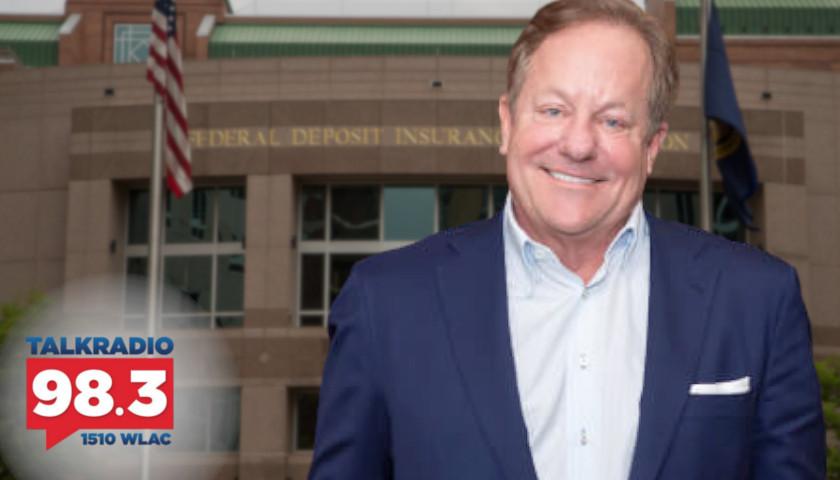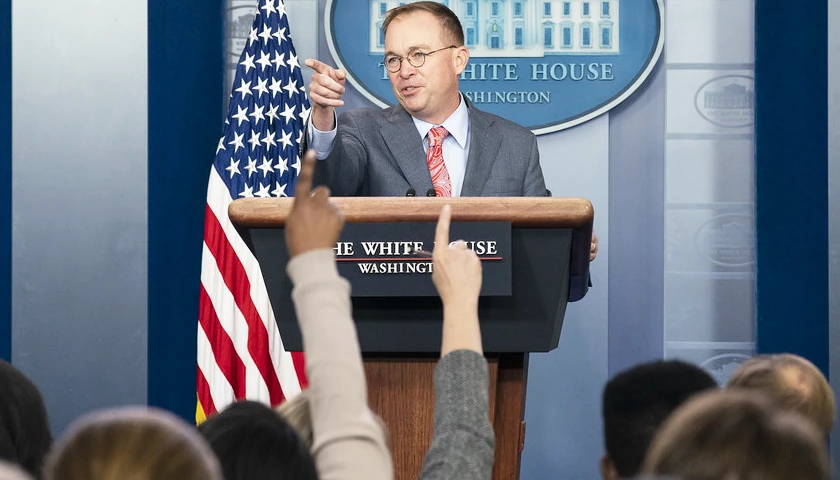Live from Music Row, Wednesday morning on The Tennessee Star Report with Michael Patrick Leahy – broadcast on Nashville’s Talk Radio 98.3 and 1510 WLAC weekdays from 5:00 a.m. to 8:00 a.m. – host Leahy welcomed the founder of CapWealth Management, Tim Pagliara in studio to discuss how the Silicon Valley Bank crisis revealed flaws in the Federal Deposit Insurance Corporation structure.
Leahy: In studio, our guest, our good friend, Tim Pagliara, founder of CapWealth Management. Often the number one-rated wealth management company here in Tennessee. I think you’re this year again, too, right?
Pagliara: We’re waiting to see.
Leahy: Waiting to see. I think my prediction, my predictions, by the way, are better than Jim Kramer’s predictions. (Laughter) My classmate who a month before said you should buy Silicon Valley Bank.
Pagliara: Two days before.
Leahy: Two days before, buy Silicon Valley Bank at $260. And what’s the value of it today, Tim?
Pagliara: It’s a goose egg. Zero.
Leahy: Zero. Okay, so I just have to talk about this. Supposedly the top government official who handles financial matters is the Secretary of Treasury Janet Yellen. I noticed that as Silicon Valley Bank was starting to melt down, she decided it’d be a good time to go to Kyiv, Ukraine. (Laughs) I don’t know. You can’t make this stuff up. Was she able to help any of the banks there?
Pagliara: I don’t think so.
Leahy: I don’t think so either. Now let’s talk about Silicon Valley Bank and how our listeners have their demand deposit money. This is like if you go to a bank and you have a checking or a savings account, that’s what you call a demand deposit, right?
Pagliara: Yes.
Leahy: Which means you can demand that deposit back and you get it, you’re supposed to get it right then. If you’re an FDIC-insured bank, the demand deposits are insured up to $250,000, is that right?
Pagliara: That’s correct.
Leahy: So if you’re at a bank that fails and you had $250,000 in your bank account, you could get that money ultimately from the FDIC insurance mechanism. But if you had $260,000, in theory, you could get $250,000 back, but you’d lose $10,000 bucks. But that’s not gonna happen here, is it?
Pagliara: No, they’ve guaranteed the deposits. And what this has revealed is a structural flaw in the FDIC system. It’s going to have to be revamped because part of those demand deposits that you were talking about payroll falls into that category. And so the biggest problem that they had closing on Friday and reopening on Monday was there were companies that were not going to be able to meet payroll.
Leahy: That would not have been good.
Pagliara: No. And that’s why you think of $250,000 as a great savings account, but it really doesn’t match what flows through a bank with payroll.
Leahy: If you’ve got a company of the business side, a business account in order to be able to meet payroll, sometimes you need to have what, a million bucks? Two million bucks? Five million bucks depending on the size of the company.
Pagliara: The estimates to the people that I talked to in New York that they will have to extend insurance on payroll accounts when they revamp this $100 million.
Leahy: That high?
Pagliara: That high because you’ve got just tremendous amounts of money that flow through banks, and we have to have the confidence. That when we put it in there and we need it for payroll, for rent, or whatever, is a small business, it’s going to be there.
Leahy: The governing body is a federal deposit insurance corporation, FDIC that was founded in 1933 in the midst of the Great Depression after a whole bunch of banks failed and people lost their demand deposits. But right now, how is that money funded? In other words, where do you get the money to cover the $250,000 or more? Where does that come from?
Pagliara: It’s a tax on banks. And so they pay a percentage of their deposits and their profitability, et cetera.
Leahy: There’s a little fund that the FDIC has?
Pagliara: Yes.
Leahy: And when the bank fails, they go to that fund. And that fund is then used to cover all those demand deposits. Is that right?
Pagliara: That’s correct.
Leahy: I’m told that fund doesn’t have enough money right now to cover all the demand deposits at Silicon Valley Bank. Is that true?
Pagliara: That’s true.
Leahy: Uh, oh.
Pagliara: This is what Warren Buffet always says. Now we know who’s been swimming naked because the tide’s gone out.
Leahy: Is that what he says?
Pagliara: Oh, yeah.
Leahy: That’s funny.
Pagliara: It is. Especially this time in the morning. So it’s a structural flaw in the system that’s been revealed by this massive rapid increase in interest rates and then the policies.
Leahy: So this fund is not gonna have enough money to cover all the demand deposits et cetera in Silicon Valley Bank. What’s gonna happen to cover them, then?
Pagliara: You’ve gotta focus on how much money was really lost. And I don’t think there’s going to be a lot of money lost unless they get into the loan portfolio. That’s where the big losses occur.
Leahy: In other words, when you say the loan portfolio, it’s, I loan money to a business, and they’re not able to pay it back. That’s the risk. And then you lose all the money.
Pagliara: That’s a historical risk. That’s why I said this is unique. It’s the first time a bank has ever failed in this country that wasn’t credit risk related. It wasn’t because loans failed.
Leahy: It was, it’s because they made bad investment decisions.
Pagliara: They made bad investment decisions. They didn’t manage their investment portfolio correctly. They didn’t have a risk officer for over a year.
Leahy: Okay, so now it’s almost impossible for me to wrap my head around this idea, right? A fifth grader could have figured out, oh, interest rates are going up. I gotta get out of these low interest-rate treasury bonds.
Pagliara: That’s right.
Leahy: How hard is that to figure out?
Pagliara: It’s not, it’s something you would do every month, and on top of everything else, they were not paying their depositors. They weren’t ramping up payments to depositors. When is the last time you got a call from your banker, and he said, hey, why don’t you put your money in a six-month treasury bill at five percent instead of the one percent I’ve been paying you?
(Leahy laughs) So enough people got together on the golf course and over coffee and dinner, and they said, what are you getting at your bank? I just moved my money to treasury bills at five percent. I’m only getting one percent. What do you think happens?
Leahy: Boom. Money moves.
Pagliara: Now you start a behavioral move; money goes in motion. That’s why that deposit beta accelerated so fast beyond anything that they could have anticipated.
Leahy: So the investigators are gonna look at this and, oh, by the way, the CEO, Greg Becker, this guy. Do you see he sold like $3 million bucks of stock which is like a couple weeks ago, wasn’t it? He can read the balance sheet.
Pagliara: That’s gonna lead to some really interesting questions and depositions.
Leahy: Does he go to prison?
Pagliara: I don’t think so. Tell me the difference between stupid and unethical and I could send my brother-in-law to jail as that saying, went in The Big Short. (Leahy laughs)
Leahy: But he went to a top business school, Tim. I don’t know which one it was. Probably Stanford, probably the same one I went to. He’s stupid with a Stanford MBA or whatever the MBA was, right?
Pagliara: I guess. Yes.
Leahy: It seems to me it is just so obvious. This risk officer thing. If you’re running a big bank, the 16th largest bank in the country, why do you leave the risk officer position open for a year?
Pagliara: That’s gonna be a very interesting question that they’ll have.
Leahy: I can’t imagine that.
Pagliara: I know. Part of the responsibility for this is the regulators. How do the regulators allow a position, an important position like that to be vacant for a year?
Listen to today’s show highlights, including this interview:
– – –
Tune in weekdays from 5:00 – 8:00 a.m. to The Tennessee Star Report with Michael Patrick Leahy on Talk Radio 98.3 FM WLAC 1510. Listen online at iHeart Radio.
Photo “Tim Pagliara” by Tim Pagliara. Background Photo “Federal Deposit Insurance Corporation” by Tony Webster. CC BY 2.0.





